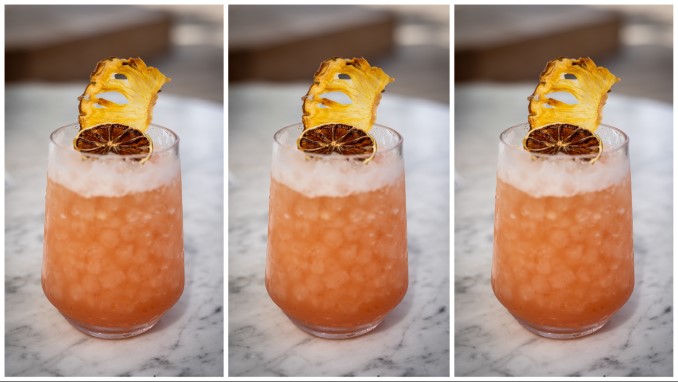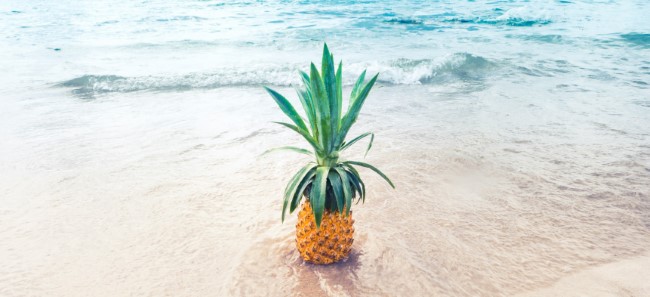Cocktail Spotlight: The Jungle Bird
Photo via Alexandra Tran, Unsplash
Cocktail Queries is a Paste series that examines and answers basic, common questions that drinkers may have about mixed drinks, cocktails and spirits. Check out every entry in the series to date.
The genre of tiki cocktails, and by extension the wider realm of what we might think of as “tropical” cocktails, together have a bit of an odd relationship with pineapple.
Pineapple is ubiquitous in the tropical cocktail world, and is probably one of the first things an outsider thinks of when you say “tropical cocktail” or “tiki cocktail.” The image of pineapples being used as drinking vessels is everywhere, and have been for a long time. And yet, despite the prominence of pineapple in classic tropical drinks such as the piña colada, or tiki standards like the Painkiller, the actual use of pineapple in tiki drinks has a tendency to be somewhat overstated. Put simply, pineapple isn’t really quite as common as it’s depicted, and in many cases it has a tendency to be used where it doesn’t really belong, especially in modern attempts to make classic tiki drinks, or at bars/restaurants that don’t really respect classic recipes. That’s how you end up with so many mai tais containing pineapple juice, even when those mai tais have nothing to do with the Hawaiian version of the drink. People fall back on pineapple as a sort of crutch, which can make tiki geeks a little suspicious of its inclusion in general. But there certainly are tiki cocktails where pineapple is indispensable, and the Jungle Bird is surely the most prominent and popular example.
Today, the Jungle Bird is one of the most popular and widespread tiki cocktails in the canon, one that I included in my list of 10 tiki drinks that every home bartender should know. And it’s easy to see why the drink is so popular, because it’s one of the more simple to make, friendly and easygoing cocktails in the genre. A lot of that is thanks to the familiar sweetness of pineapple juice, but the Jungle Bird’s use of Campari is a critical aspect that elevates it from the status of hotel pool blender drink to something more interesting. It’s both an easily approachable drink that can be used to get someone interested in rum/tiki cocktails for the first time, and nuanced enough that even a tiki snob will probably still enjoy it. That double life aspect is native to the Jungle Bird.
With that said, the drink has always had a slightly outsider status to the tiki canon, because it wasn’t created by one of the mythic forefathers of the genre–it’s not a drink from the likes of Donn Beach or Trader Vic that hails from the golden era of tiki. Rather, it was created in the 1970s at Malaysia’s Kuala Lumpur Hilton by bartender Jeffrey Ong inside the hotel’s Aviary Bar, which inspired the name. This is a time period that doesn’t give us many tiki classics, as the genre was already in retreat in the U.S. by this point, with recipes frequently being changed and dumbed down thanks to the encroachment of clear spirits and a taste for “lighter” flavor profiles. It also means that the Jungle Bird wasn’t widely adopted in the U.S. until the cocktail revival of the 2000s, following Jeff “Beachbum” Berry publishing it in one of his influential cocktail tomes in 2002. Only since that point has the Jungle Bird flourished into becoming a ubiquitous part of bar menus throughout the U.S. You will even find multiple bars in our hemisphere with the name “Jungle Bird” in its honor.
So with no further ado, here’s the standard recipe for the Jungle Bird.
— 1.5 oz Jamaican or Demerara (Guyana) rum
— 1.5 oz pineapple juice
— .75 oz Campari
— .5 oz lime juice
— .5 oz demerara/brown sugar syrup
Combine all ingredients in a cocktail tin/shaker with ice. Shake well to chill and dilute, then strain into a lowball or highball glass filled with crushed ice. Standard garnishes include a pineapple slice, pineapple frond, or ring of dehydrated pineapple. Note: Historically, this drink has sometimes been served from ornate, bird-shaped drinking vessels, some of which you may be able to find online.

This is the Jungle Bird as it is typically made today, and there are a few things to note. When it comes to the rum, lightly to moderately aged Jamaican rum tends to be the fallback ever since Jeff Berry published the recipe, but it is also common to use Guyanese rum, or both of them together. This cocktail also often sees the use of “black” rums that have some degree of food coloring, which lends a richer color to a drink that is always going to be red-tinged because of the Campari. Like the mai tai, this sometimes includes a “floater” of colored black rum on the top of the drink–not exactly tiki traditional, but plenty popular at various bars.
Pineapple is absolutely the signature flavor profile here, even though the actual proportion of pineapple has decreased over the years. As originally conceived, the drink had more than twice as much pineapple juice, resulting in a lower proof, quaffable drink you probably would have put in a larger glass. Over time, the pineapple has been decreased to create a more strongly flavored, rum-forward cocktail that is significantly more assertive and punchy. Other flavors in the cocktail, such as the demerara syrup, play nicely with the pineapple to suggest something like upside down cake. Regular simple syrup could be used here, but the drink will lose some of the sticky/caramelized quality you want in a Jungle Bird.
This significant sweetness is balanced by the Campari in the recipe, which is doing some heavy lifting here to keep the drink from coming off as cloying or dominated by pineapple. Campari or other bitter red Italian amari are sometimes used in tiki recipes for this same reason, to provide a delicate balancing bitterness. In comparison to the likes of the Lost Lake cocktail, though, where the Campari is a very subtle thread through a complex flavor profile, here the Campari is in a much more visible starring role. It forms a triumvirate with the rum and pineapple, where each element is speaking fairly strongly at the same time. With that said, this also isn’t like some rummy twist on the Negroni–the Jungle Bird is not so bitter, and much sweeter. You can’t miss the Campari, but you’re also not likely to think it’s too prominent.
And that’s really all one needs to know about the venerable Jungle Bird. It’s a cocktail that, once you learn the recipe, you’ll find seems to fit in most situations. It can be adapted to add other liqueurs or flavors quite easily. Want to make a spicy one? That will probably work out just fine. Want to use overproof rum? Should still be perfectly palatable. It’s a drink that relies on easily obtained ingredients, which the possible exception of the demerara syrup–but that’s worth going out of your way to get.
Trust me. Once you start making this drink, you’ll probably be making it frequently. Tropical classics don’t get much more approachable or easy.
Jim Vorel is a Paste staff writer and resident beer and liquor geek. You can follow him on Twitter for more drink writing.